Website personalization is the practice of tailoring the user experience depending on individual preferences, behaviors, and interactions. A study highlights that 80% of consumers are more likely to engage when brands offer personalized experiences. Using data such as browsing history, geographic location, and past purchases, B2B SaaS businesses can create relevant and engaging content for each visitor.
Such customization leads to a user-centric experience, enhancing engagement, improving conversions, and building stronger relationships with customers. In this blog, we will explore some of the top website personalization examples that align with their audience preferences and improve conversion rates in 2025.
Key Insights:
- Improved user engagement: Personalization leads to higher engagement rates by providing users with relevant content, offers, and recommendations tailored to their interests and needs.
- Higher conversion rates: Tailored content and targeted CTAs increase the likelihood of users taking desired actions, driving up conversion rates and overall sales.
- Enhanced customer loyalty: Personalized experiences foster stronger emotional connections with users, leading to increased retention and encouraging repeat visits.
- Better content relevance: By presenting content that aligns with user interests, website personalization enhances the relevance of what’s shown, making interactions more meaningful.
- Increased revenue opportunities: Personalized product recommendations and offers increase upsell and cross-sell opportunities, directly impacting revenue growth.
How Does Website Personalization Work?
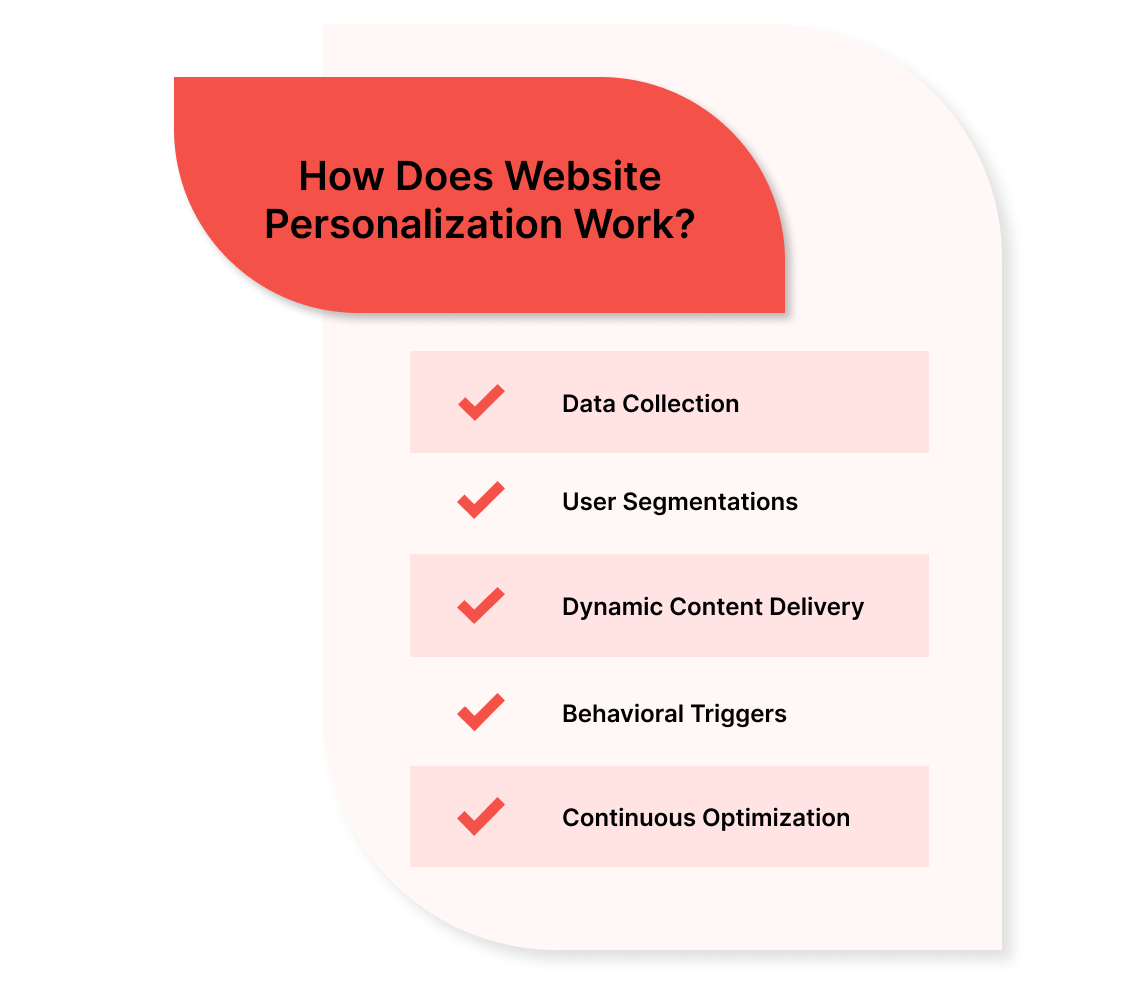
Website personalization utilizes data collected from users to tailor their experience in real-time, ensuring that content and recommendations are relevant to each visitor. A survey showcases that 63% of B2B companies are investing in improving their user experience with new personalization features.
Here’s how website personalization works:
- Data collection: Websites track user behavior, such as browsing history, geographic location, and interactions with content or products. This data is gathered through cookies, form submissions, or user accounts.
- User Segmentations: Based on the collected data, users are grouped into segments that share similar characteristics, such as demographics, interests, or purchase history. It helps create targeted experiences for each group.
- Dynamic content delivery: The website dynamically adjusts its content and page layout based on the user's assigned segment. For example, product recommendations, landing pages, or offers are tailored to align with user preferences and needs.
- Behavioral triggers: Personalization can also be triggered by specific user actions, like cart abandonment or frequent visits to a particular product category. These behaviors trigger personalized offers or reminders to encourage the user's further engagement.
- Continuous optimization: Website personalization is enhanced by UX analytics, which track user interactions and feedback, allowing for real-time adjustments to content and design. Machine learning algorithms can adjust content and offers to enhance conversion rates as the website collects more data.
Before moving into website personalization examples, let’s explore some of the benefits SaaS business owners can attain.
What are the Benefits of Website Personalization?
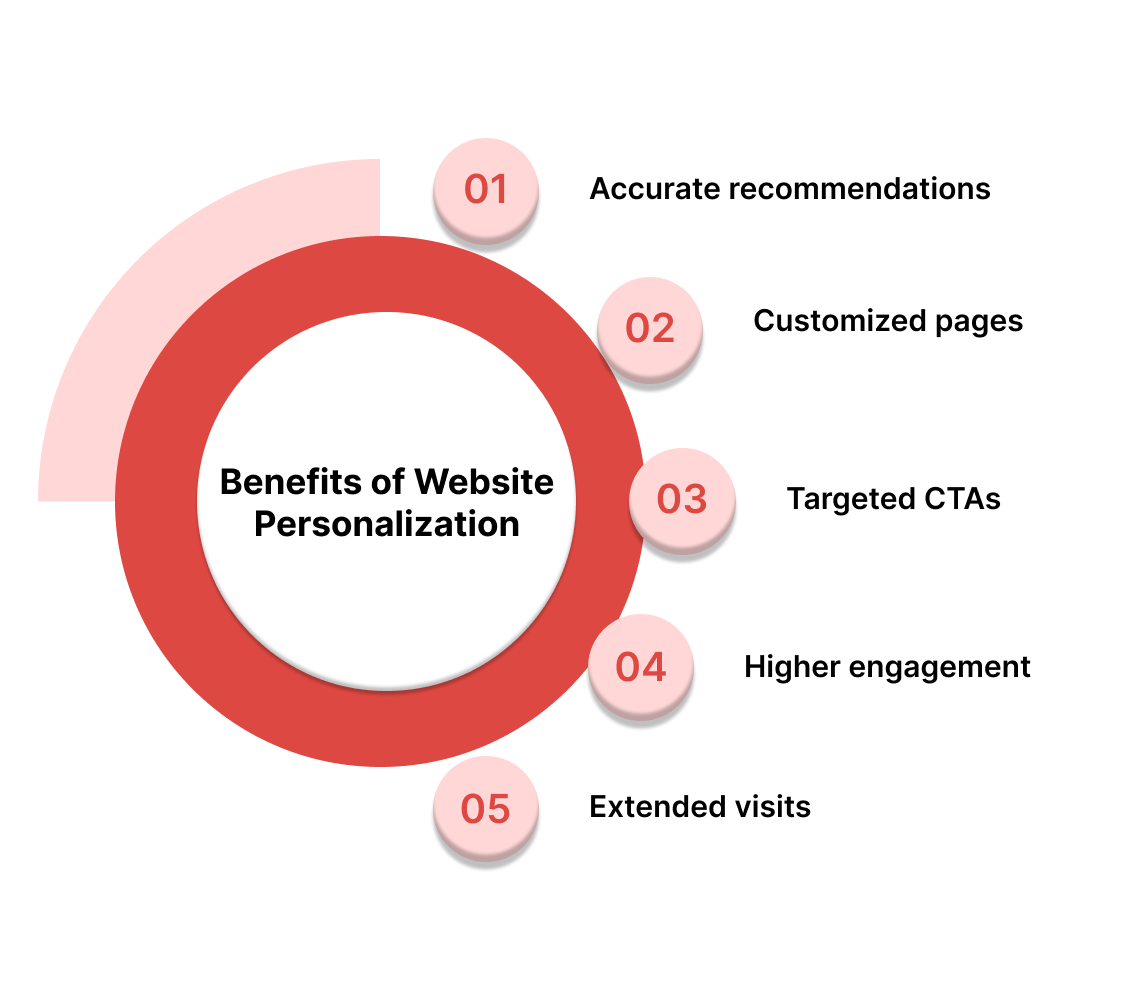
Website personalization tailors the user experience by adopting content, offers, and messaging depending on individual user behavior, demographics, and preferences.
- Accurate product recommendations: Personalizing product suggestions based on past user behavior, preferences, and browsing patterns helps customers explore products, increasing purchase likelihood and driving higher average order values.
- Customized landing pages: Tailored landing page UI designs, which adapt to a user’s location, behavior, or demographics, deliver content that aligns with their needs, improving relevance and enhancing the overall chances of conversion.
- Targeted CTAs: Personalized call to action (CTAs) that reflect the user’s journey and intent increase the likelihood of engagement, making them more compelling and driving higher conversion rates.
- Higher engagement rates: Personalization creates a more dynamic user experience, capturing users’ attention with content and offers that align with their specific interests, resulting in more extended site visits and more meaningful interactions.
- Enhanced site visit time: By providing content that aligns with individual interests, personalization enables users to spend more time on the site, resulting in increased interactions and a stronger brand connection.
Let’s now explore some of the prominent website personalization examples in 2025:
10 Best Website Personalization Examples
According to a McKinsey report, personalized content generates 40% more revenue than traditional methods. The following website personalization examples illustrate how personalized strategies can enhance conversion rates and enhance user engagement.
1. Mailreach
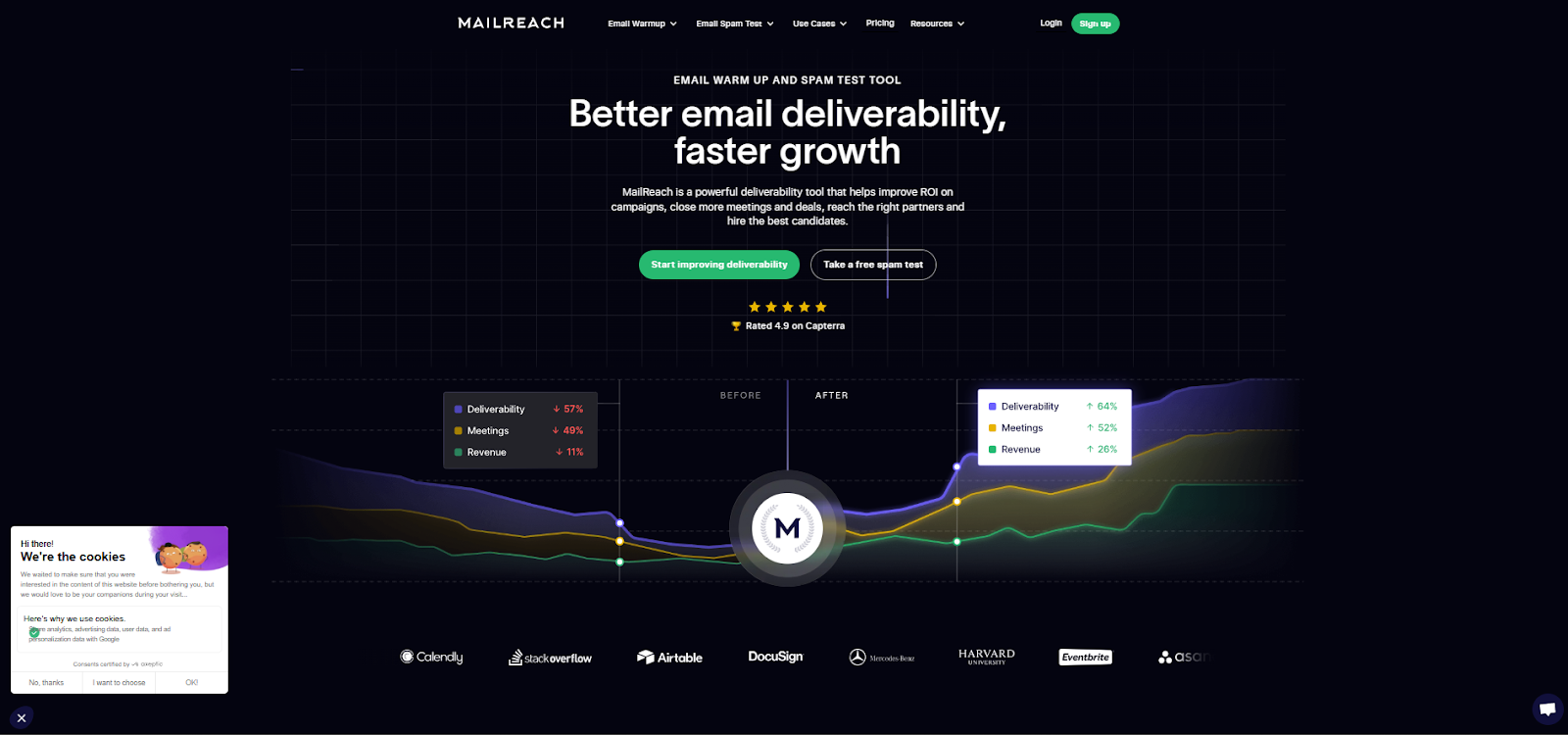
Source: Mailreach website
Mailreach is an email deliverability platform designed to improve inbox placement and sender reputation. It offers AI-powered email warm-up, spam testing, reputation monitoring, and more.
Why it works:
- AI-powered warm-up: Simulates natural email interactions to build a positive sender reputation over time.
- Comprehensive spam testing: Mailreach provides tools to check inbox placements and identify potential spam triggers.
- Real-time reputation monitoring: Mailreach provides insights into domain and IP health, alerting users to potential issues that may arise.
2. Avoma
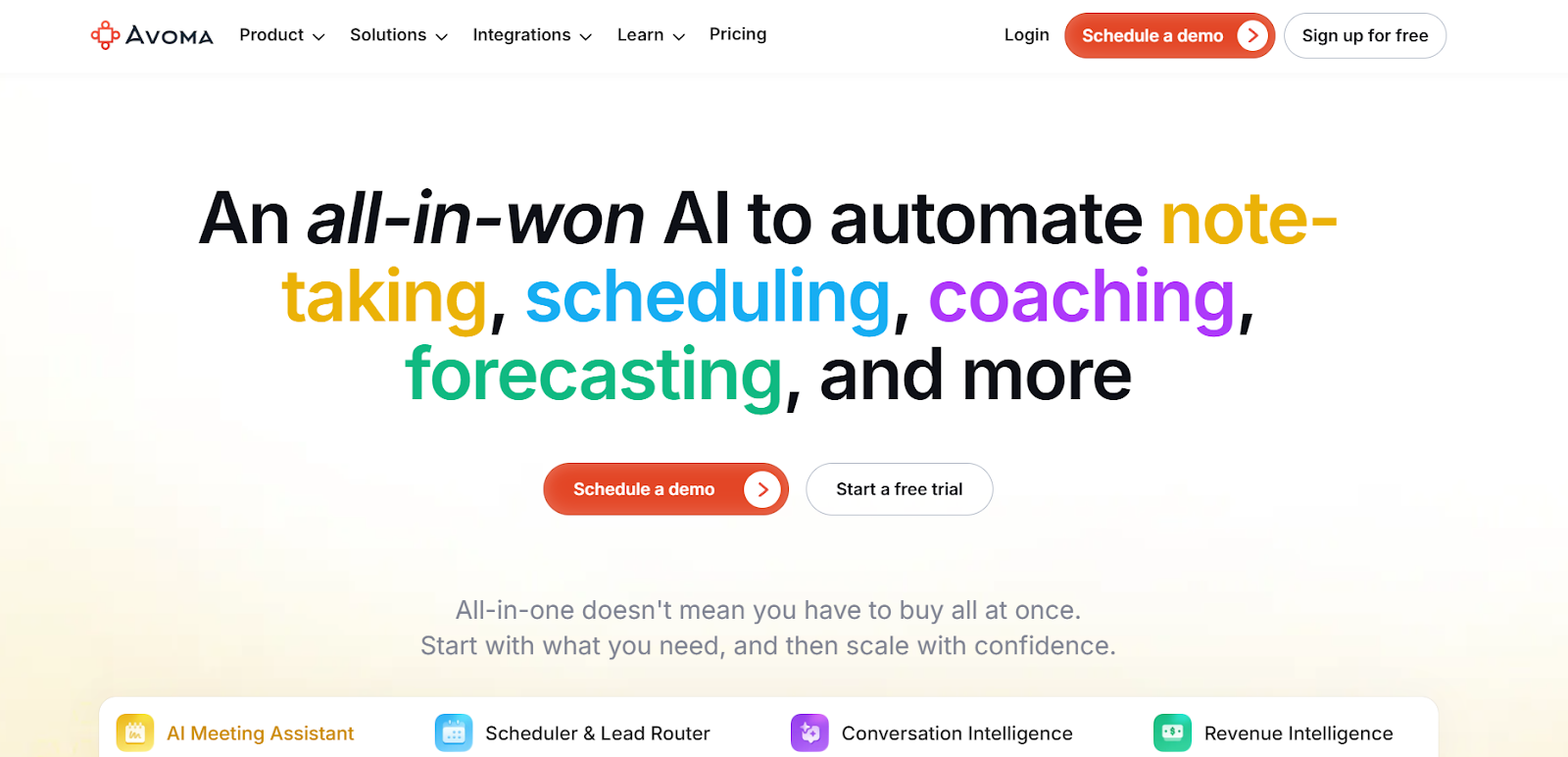
Source: Avoma website
Avoma is an AI-driven meeting assistant that enhances sales and customer success workflows through automated note-taking, coaching, and CRM integration.
Why it works:
- AI-powered meeting insights: Automatically transcribes meetings and generates categorized notes, enabling teams to focus on engagement rather than documentation.
- Customizable smart topics: Users can define trigger prompts and keywords to extract relevant information, tailoring notes to specific business purposes.
- Integrated coaching tools: Provides AI-generated call scores and performance analytics, facilitating personalized coaching and continuous improvements.
3. Close
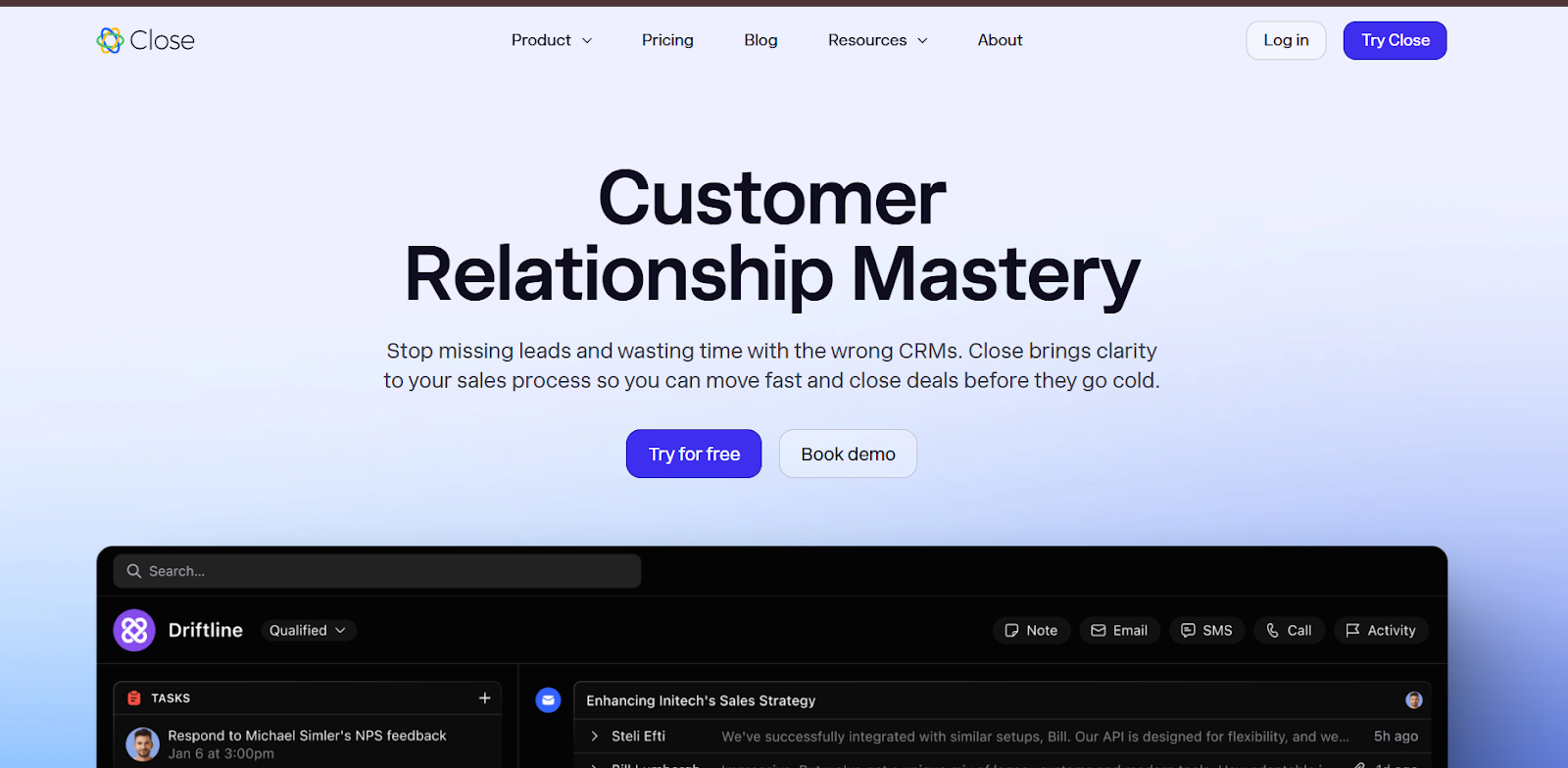
Source: Close website
Close is a CRM platform designed to streamline sales processes through integrated communication tools and workflow automations. It enables sales teams to manage leads, track interactions, and close deals more efficiently.
Why it works:
- Integrated communication tools: Close consolidates SMS, calling, and email into a single platform, simplifying outreach and follow-up processes.
- Customizable workflows: Users can automate tasks and set up triggers to streamline repetitive sales activities, enhancing efficiency.
- Comprehensive reporting: The platform offers analytics and reporting features, providing insights into sales performance and pipeline health.
4. Acorn
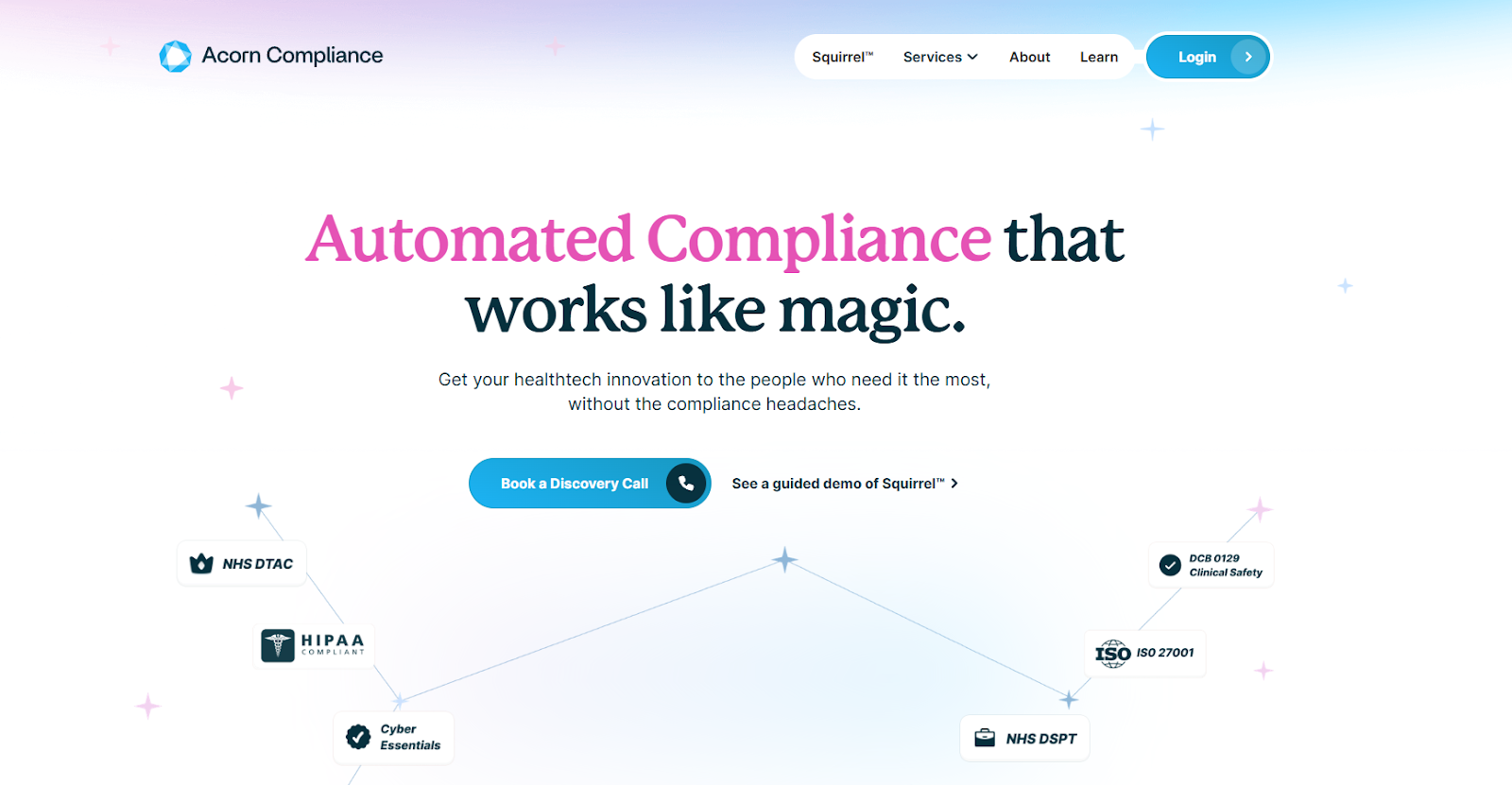
Source: Acorn website
Acorn is an AI-powered learning management system (LMS) designed to align employee development with business performance. It offers personalized learning journeys and real-time performance analytics.
Why it works:
- Real-time analytics: Acorn provides actionable insights into learner progress and performance, enabling timely interventions and informed decision-making.
- AI-driven personalizations: Acorn tailors learning experiences to individual roles, ensuring relevance and increasing overall engagement.
- Scalable integration: Acorn integrates with existing HR systems, enabling smooth adoption across multiple organizations.
5. Fyno

Source: Fyno website
Fyno is a no-code, omnichannel communication platform that enables businesses to manage customer interactions across multiple channels, including SMS, email, WhatsApp, in-app messaging, and push notifications.
Why it works:
- Unified communication API: Fyno consolidates messaging channels, vendors, logic, templates, and teams, streamlining communication workflows and enhancing overall efficiencies.
- Real-time messaging: Fyno provides instant messaging delivery for the users, which is critical for time-sensitive communications.
- Cost optimizations: It reduces customer communication costs effectively through intelligent orchestration and AI-driven insights for targeted messaging strategies.
6. Review Wave

Source: Review Wave website
Review Wave is a patient engagement and reputation management platform tailored for healthcare practices, including chiropractic and optometry clinics. It automates review collection, appointment scheduling, and communication to enhance overall patient acquisition and retention.
Why it works:
- Automated review generation: Sends patients review requests, follows up with spaced-out reminders, intercepts poor reviews, and ranks practices high on Google, Facebook, Yelp, and other leading sites.
- Integrated Communication Tools: Review Wave offers business 2-way texting using your business number, enabling automated and manual text messages, saved replies, and video messages.
- Customizable website templates: Provide customizable website templates designed to increase online reviews, ranking, recall, retention, and new patients.
7. Instantly
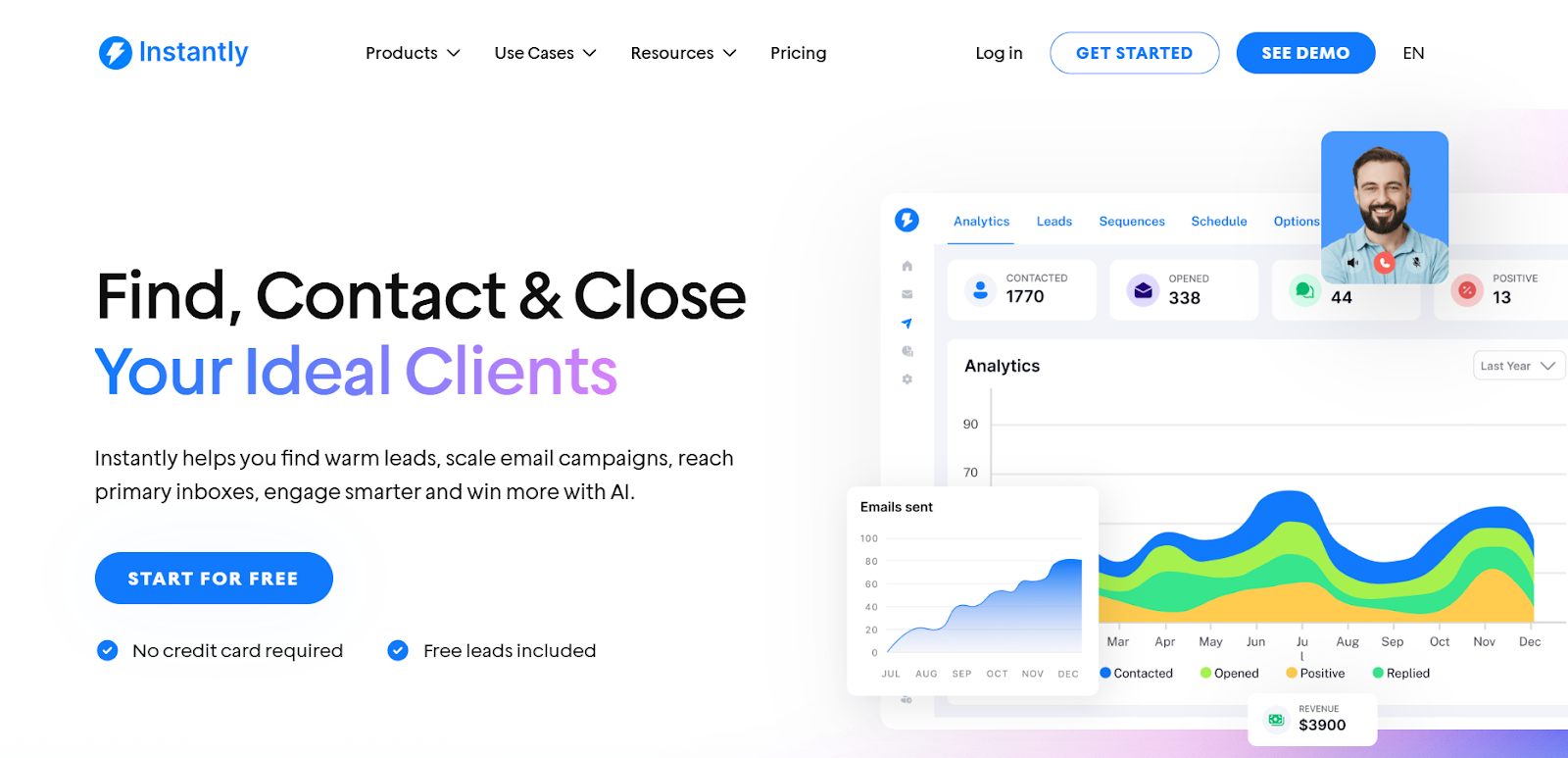
Source: Instantly website
Instantly is an AI-powered sales engagement platform designed to streamline cold email outreach, lead generation, and campaign management. Instantly ensures businesses scale their sales efforts by automating key processes, enhancing deliverability, and providing advanced analytics.
Why it works:
- Unified Inbox (Unibox): Instantly consolidates responses from multiple email accounts into a single interface, streamlining communication and lead management.
- AI-powered personalization: Instantly uses AI to create personalized email sequences and automate follow-ups, increasing engagement and response rates.
- Advanced analytics: Instantly provides detailed insights into campaign preferences, including open rates, click-through rates, and conversions, enabling data-driven decision-making.
8. Hakimo

Source: Hakimo website
Hakimo is an AI-powered physical security platform founded by Stanford AI researchers that integrates with existing security infrastructure, offering proactive monitoring without hardware upgrades.
Why it works:
- AI-driven threat detection: Hakimo utilizes computer vision and machine learning to identify anomalies, such as unauthorized access or tailgating, in real-time.
- Seamless integration: Hakimo is compatible with existing ONVIF-compliant cameras and access control systems, allowing quick development.
- Automated response protocols: It issues real-time audio warnings and escalates incidents to human operators only when necessary, ensuring timely interventions.
9. Infisign
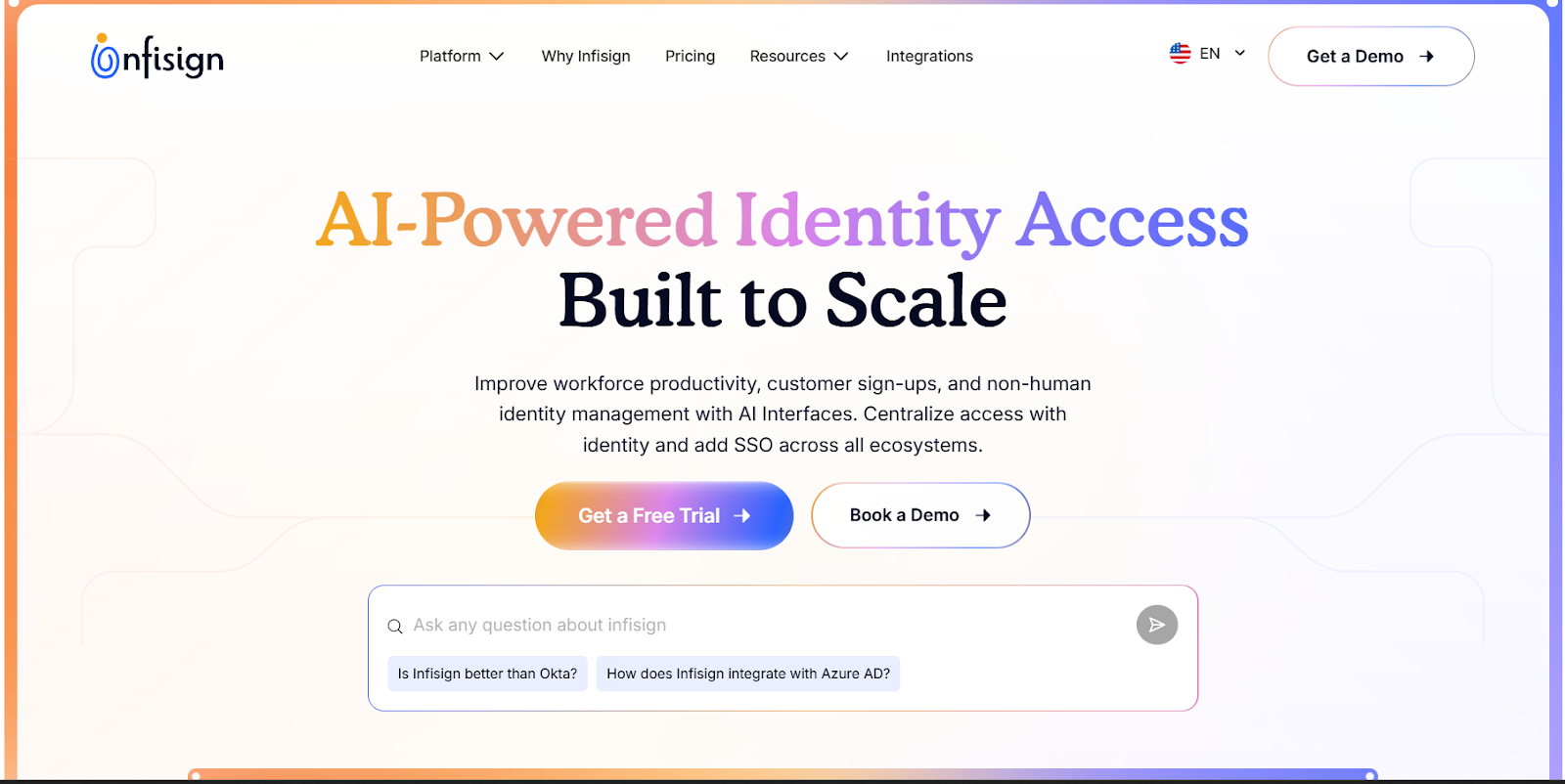
Source: Infisign website
Infisign is an advanced identity and access management (IAM) platform that uses decentralized identity protocols to enhance digital security and user experiences. It offers solutions for both workflows and customer identity management, including passwordless authentication, single sign-on (SSO), and privileged access management (PAM).
Why it works:
- Decentralized identity management: Infisign Uses blockchain-based decentralized identifiers (DIDs) to eliminate the need for traditional passwords, enhancing security and user privacy.
- AI-powered automation: Incorporates AI-driven workflows for user provisioning, access reviews, and threat detection, reducing manual intervention and improving efficiency.
- Comprehensive integration: Infisign supports integration with a wide range of applications and platforms, including Salesforce, NetSuite, and Microsoft Azure, ensuring IAM across ecosystems.
10. Spendflo
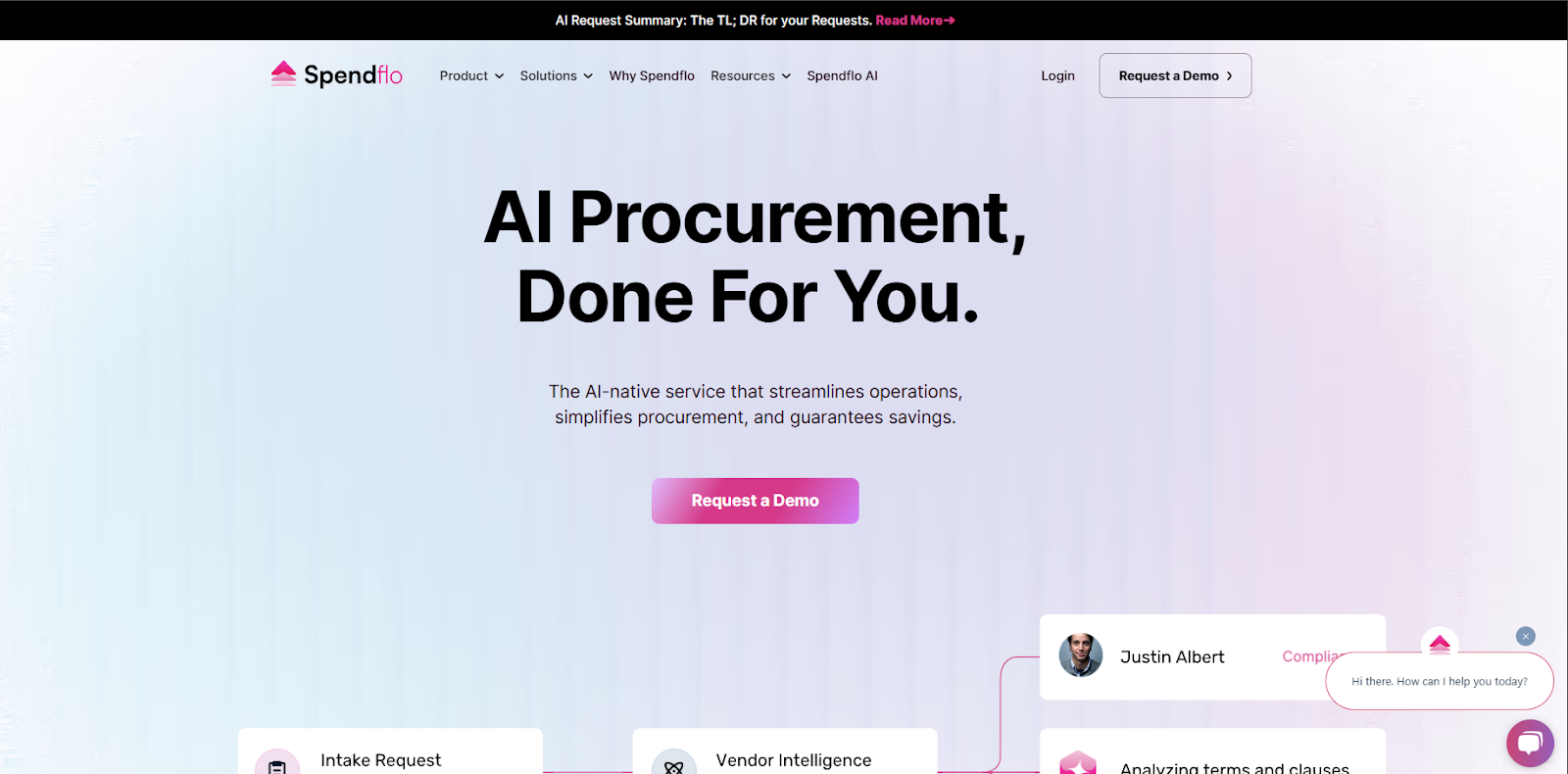
Source: Spendflo website
Spendflo is a SaaS procurement and spend management platform designed to streamline the entire software acquisition lifecycle for discovery and negotiation to renewal and optimization. Its Slack-first interface and vendor intelligence features enable collaboration and informed decision-making.
Why it works:
- AI-powered procurement: Spendflo automates vendor intake, approvals, and negotiations, reducing manual efforts and procurement processes.
- Centralized vendor management: Spendflo consolidates vendor data, contracts, and performance metrics in one platform, enhancing control and visibility.
- Real-time speed insights: Spendflo provides analytics on usage, sentiment, and spend, enabling organizations to optimize their SaaS investments.
Also read: Unlocking B2B Website Personalization: Strategies That Drive Conversions for SaaS Brands.
How Beetle Beetle Can Help With Website Personalization?
Beetle Beetle specializes in helping B2B SaaS businesses implement effective website personalization strategies that enhance engagement and conversions. We analyze audience behavior and historical data to develop tailored content strategies that align with user preferences.
With over 100 SaaS clients, including Mailreach and Close, we have consistently delivered websites that increase conversions and user engagement. Our approach integrated strategic design with performance optimization, ensuring that each websites look appealing and functions as a powerful sales tool.
If you are ready to convert your website into a high-performing asset, hire Beetle Beetle for website personalization today.
FAQs
1. Can website personalization work for SaaS businesses?
Yes, SaaS businesses benefit from personalization by targeting users depending on their specific needs or usage patterns. Personalized CTAs, content, and product recommendations increase both retention and sales. It’s a critical strategy for converting visitors into loyal customers.
2. What are the best data sources for effective website personalization?
Key data sources for personalization include browsing history, purchase behavior, geographic location, and demographic details. These data points allow businesses to segment users effectively. With this information, they can deliver highly relevant content, resulting in improved engagement.
3. How does personalization impact conversion rates?
Personalized content delivers tailored recommendations, offers, and messaging that align with user needs. By addressing specific pain points and interests, it encourages users to take desired actions. Such a targeted approach significantly enhances overall conversion rates.
4. What are the key technologies behind website personalization?
Website personalization relies on AI, machine learning, and user data tracking technologies. These tools enable dynamic content delivery and behavioral triggers that adjust the experience in real-time. Such technologies help increase both user satisfaction and conversions.
5. How can website personalization improve user engagement?
Website personalization tailors content based on user preferences, behavior, and location. This relevance enhances engagement by providing visitors with the most relevant information. The result is more extended visits and higher interaction rates.


.png)


.jpg)
.png)
.jpg)
























